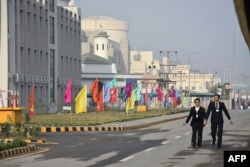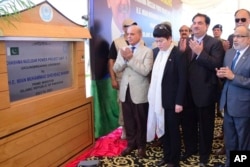Pakistan held a groundbreaking ceremony Friday for what will be its largest civil nuclear power plant — constructed by China — that will contribute 1,200 megawatts of electricity daily to the national grid and is estimated to cost at least $3.5 billion.
Prime Minister Shehbaz Sharif and senior Chinese officials attended the televised event in the central city of Chashma, dubbed the birthplace of China-Pakistan nuclear energy cooperation.
Over the past 30 years, Beijing has installed four nuclear power generation units in Chashma, collectively generating about 1,300 megawatts, with China providing enriched uranium for fuel.
"This mutual cooperation to promote clean, efficient, and comparatively cheaper energy is a gift of friendship between the two countries and a model for other countries to emulate," Sharif said at the ceremony.
The plant, known as Chashma-5, or C-5, will feature what China says is its domestically developed third-generation pressurized water nuclear technology, the Hualong One or HPR1000, with "advanced safety and foolproof security features."
Raja Ali Raza, the head of the Pakistan Atomic Energy Commission, said the nuclear plant project will be completed by 2030.
"C-5 will be Pakistan's largest generation-III plus nuclear power project," Raza said. "This project has brought PAEC one step closer to its envisaged goal of production of 8,800 megawatts electric cheap and clean energy."
Beijing has previously supplied the HPR1000 technology for two nuclear power stations, each with a 1,100-megawatt generation capacity, built and operationalized in the last couple of years in the southern port city of Karachi, enhancing Pakistan's nuclear energy production to more than 3,500 megawatts a day.
Analysts see China's accelerated civil nuclear cooperation with Pakistan as part of efforts to globally find more lucrative buyers for its HPR1000 reactors developed by state-owned China National Nuclear Corporation or CNNC, the country's second-largest nuclear power producer company.
"HPR1000 is a homegrown nuclear technology of CNNC and a flagship of China's advanced equipment manufacturing," Yu Jianfeng, the CNNC chairman, told the ceremony. He noted that more than 17 units of HPR1000 are currently under construction in China.
"Today's groundbreaking for the C-5 project is a significant milestone for HPR1000's global journey and a new start for the China-Pakistan nuclear energy cooperation," Yu stated. "Our cooperation in nuclear energy has become an integral part of the China-Pakistan all-weather strategic cooperative partnership and a shining example of international nuclear energy cooperation."
Under its global Belt and Road Initiative, Beijing also has built and put into commercial operation 14 mostly coal-fired power plants in Pakistan in the last 10 years, with a total installed capacity of 8,000 megawatts daily.
The projects are part of the China-Pakistan Economic Corridor, or CPEC, which has also built road networks, highways, ports, and industrial zones with direct Chinese investment and "soft loans," expected to increase to about $62 billion by 2030 when the mega undertaking is due to be complete.
Critics blame CPEC for contributing to Pakistan's deepening economic troubles and depleting foreign exchange reserves, making it difficult for the country to catch up with its foreign debt repayments.
Pakistan owes more than $1.3 billion (350 billion rupees) to Chinese power plants. The amount keeps growing, and China has refused to defer or restructure the payment and CPEC debt repayments.
All the Chinese loans – both government and commercial banks – make up nearly 30% of Islamabad's external debt. Pakistani and Chinese officials reject the criticism, saying CPEC has stimulated the economy and produced nearly 200,000 jobs for locals since it was launched a decade ago.
On Friday, Sharif thanked China for rolling over several billion dollars' worth of loans in recent weeks to help his country tackle declining foreign exchange reserves and avert default.
"The Chinese government and commercial banks rolled over amounts back to Pakistan to the tune of more than $5 billion. This is not a small contribution by a great friend at a time that was one of the most difficult times Pakistan was facing," Sharif told the gathering in Chashma.
Fears of default on external payments and deteriorating economic conditions forced Islamabad to negotiate and secure a much-needed $3 billion bailout with the International Monetary Fund late last month. The global lender finally approved the bailout this week, bringing relief to the embattled Pakistani government.
China's defense partnership has also significantly deepened with nuclear-armed Pakistan over the past decade but both countries maintain their nuclear cooperation is limited only to civilian purposes.
Pakistan and officials at the International Atomic Energy Agency say the country's civilian nuclear plants work in line with the global watchdog's safety guidelines.



